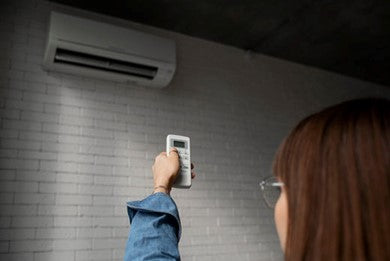
The Environmental Impact of Different HVAC Refrigerants
If you’ve ever sat indoors on a stifling summer day, you know how satisfying it can be when a cool breeze from an air conditioner kicks in—and you have a refrigerant to thank for that. In the last hundred years, the evolution of refrigerants has seen new and innovative compounds replace older, more environmentally harmful substances. Today, there are several different kinds of refrigerants in use, and we’re going to review a few of these and their impacts on the environment.

What is a refrigerant, and how can it impact the environment?
Simply put, refrigerants are chemical compounds used in heating, ventilation, and air conditioning (HVAC) systems that absorb heat from the environment and provide cool air after running through compressors and evaporators in AC units. Because all air conditioners leak gases into the atmosphere, chemicals released by refrigerants eventually reach the ozone layer, a thin part of the atmosphere that absorbs almost all of the sun’s harmful ultraviolet radiation (think of the ozone layer as a type of global “sunscreen”). Without the protection of the ozone layer, we are increasingly exposed to this radiation and the dangers it poses, like skin cancer and cataracts. As space cooling is predicted to triple by 2050, it is essential to address the environmental footprints of the refrigerants used in HVAC systems.

What types of refrigerants are there?
There are many different types of refrigerants, but here we will discuss a few of the most prevalent kinds used in the past few decades and their impact on the environment.
Chlorofluorocarbons (CFCs)
In 1928, Thomas Midgley, Albert Henne, and Robert McNary of General Motors sought to develop an alternative to substances like Sulphur dioxide and ammonia, which were used as refrigerants at the time. They produced a type of refrigerant called CFCs, also known by the brand name Freon. Due to its contribution to the thinning of the ozone layer, the use of Freon was phased out in the United States in the 1990s under the U.S. Clean Air Act and the Montreal Protocol on Substances that Deplete the Ozone Layer.
Hydrochlorofluorocarbons (HCFCs)
R22, or Freon 22, is an ozone-depleting HCFC that became the standard for air conditioners in the decades after 1960. If your HVAC system was installed before 2010, it probably uses R22 refrigerant. However, it started to be phased out in 2010 and was then banned by the EPA for use in new air conditioners in January 2020. During the phasing out process, the manufacturing and import of R22 was limited, and while it is no longer produced, recycled or stockpiled supplies of the refrigerant can still be used in older air conditioner units.
Hydrofluorocarbons (HFCs)
R-410A
When R22 was banned, a new refrigerant known as R-410A became the most prominent compound in air conditioning units. Also called Puron, R-410A is a chlorine-free refrigerant that is less harmful to the environment as it doesn’t directly contribute to ozone depletion. This is the most common refrigerant for newer commercial air conditioning systems thanks to its energy efficiency and ease of use. Because of its efficient performance compared to R22, using R-410A also helps reduce energy bills.
R-32
Today, the refrigerant R-32 is widely used throughout the world in air conditioning and refrigeration systems. It doesn’t directly contribute to ozone depletion, and because of its high efficiency, using R-32 can reduce electricity by up to 10% when compared to R22. Likewise, it has a Global Warming Potential (GWP) that is 32% lower than that of R-410A. This means R-32 emits fewer harmful chemicals and is therefore a more environmentally friendly form of refrigeration. From portable air conditioner units like the Honeywell MO08CESWK6 to whole-house air conditioning systems, R-32 refrigerant is more and more prevalent in appliances today.

New advancements in refrigerant and air conditioning technology are being made every day. Soon, the refrigerants of today will be replaced by versions that are even more environmentally friendly as the current refrigerants are phased out. By continuing to research and develop new compounds, we are on the way to creating more efficient cooling methods that can make a difference in combating climate change.
